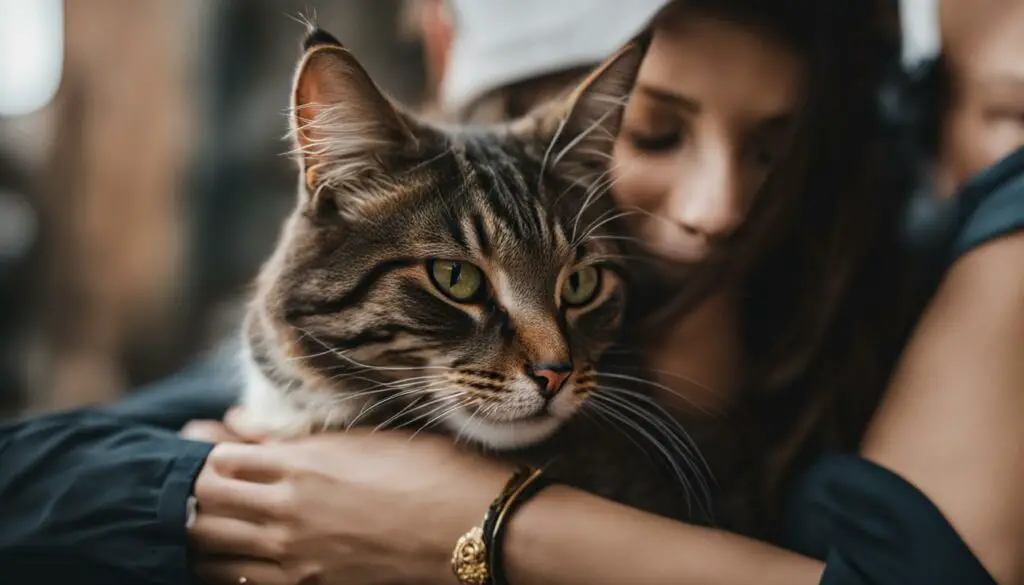I often find myself wondering why my cat loves me so much. It’s a question that many cat owners ponder. The bond between cat and human is a special one, filled with affection, companionship, and mutual love. In this ultimate guide, I will explore the reasons behind why cats love their humans so deeply and how we can nurture and strengthen that bond.
When it comes to cats, their love for us goes beyond simple companionship. Cats find pleasure, safety, and comfort in our presence. They have distinct personalities and unique ways of showing their love, from wanting to be near us to purring softly as they sit on our chests. But what influences a cat’s ability to love humans? And how can we create an environment that allows our feline companions to express their affection?
Key Takeaways:
- Cats can and do love their humans, deriving pleasure, safety, and comfort from their relationships with us.
- Socialization plays a crucial role in a cat’s ability to love humans, with a sensitive period between two to nine weeks when they become comfortable coexisting with people.
- Cats show their love through various behaviors like rubbing against us, following us into rooms, blinking slowly, and displaying their bellies or tails.
- Creating a comfortable environment is essential for cats to express their natural behaviors and build trust and a bond with their owners.
- Understanding the universality of cat love and finding a cat that fits our lifestyle can enhance the cat-human bond.
Do Cats Really Love Their Humans?
Cats are often misunderstood creatures when it comes to displaying affection towards humans. Unlike dogs, cats have their own unique love languages and boundaries. But make no mistake, cats do love their humans in their own special ways. Understanding these behaviors can help strengthen the bond between cats and their humans and create a loving relationship.
One of the ways cats show their love is through body language. They may engage in slow blinking, headbutting, grooming, and kneading, which are all signs of affection. Cats may also show their love by following their humans from room to room, using their tails to express adoration, and even meowing or purring as a way of communicating their affections.
Another sign of a cat’s love is when they treat their humans as if they were fellow cats. Cats may rub against their humans, show their bellies, and bring them presents, all behaviors typically reserved for feline companions. Greeting their humans at the door and sleeping near them are also signs of love and trust.
It’s important to remember that cats are independent animals, but they can still form strong bonds with their humans. They may not display their affection in the same way as dogs, but their love is just as real. By understanding and appreciating their unique love languages, you can deepen your bond with your feline companion and experience the joy of a loving relationship.
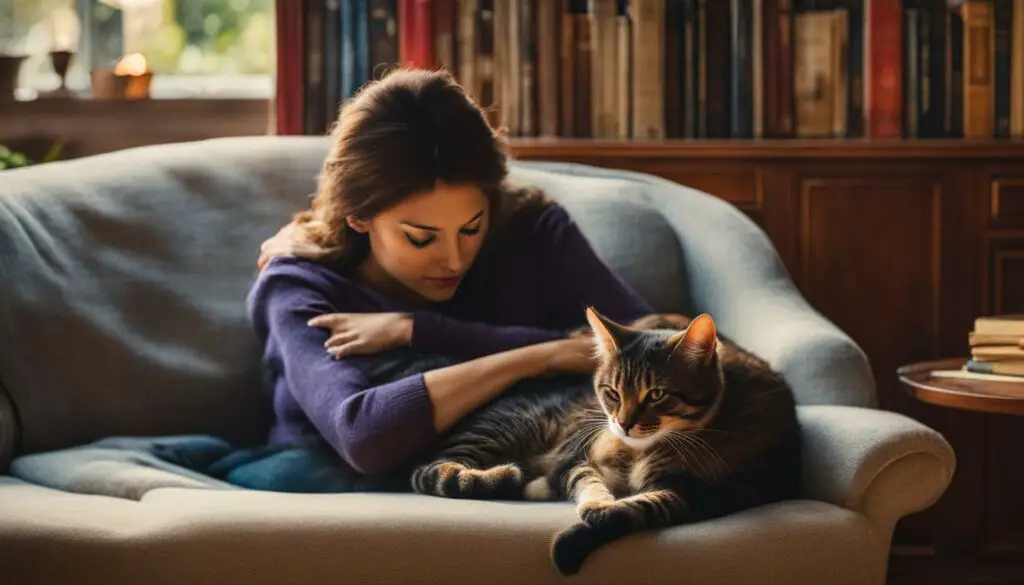
Table: Ways Cats Show Love
| Behavior | Explanation |
|---|---|
| Slow blinking | Sign of trust and affection |
| Headbutting | Marking you as part of their territory |
| Grooming | Symbol of acceptance and caretaking |
| Kneading | Relaxation and contentment |
| Rubbing against you | Marking you with their scent |
| Show their bellies | Display of trust and vulnerability |
| Bringing presents | Offering you a gift as a sign of affection |
| Sleeping near you | Choosing your presence for comfort and security |
Each cat is unique, and their ways of showing love may vary. By observing and understanding their individual preferences and body language, you can foster a deeper connection with your cat and enjoy a loving relationship filled with feline affection.
The Importance of Socialization in Cat Love
Socialization plays a crucial role in a cat’s ability to love humans. Early interactions and experiences with humans during a cat’s sensitive period between two to nine weeks old can significantly impact their comfort level and trust in people later in life. It is during this time that kittens learn to coexist with humans, and being handled gently and positively can contribute to their future ability to form loving bonds.
Adopting a kitten within this critical socialization window can enhance the bonding process and facilitate faster trust-building between the cat and their human. These early interactions help kittens become accustomed to being touched, held, and handled, leading to a more confident and affectionate adult cat.
However, if a cat has missed this socialization period, it is still possible to help them develop a bond with humans. Patience, understanding, and gradual exposure to positive experiences can gradually build trust. It is important to give the cat space and allow them to approach and initiate interactions at their own pace. Slowly introducing them to new people and environments can help them feel more comfortable and open to forming a loving relationship.
Early Socialization Sets the Foundation for Love
Early socialization sets the stage for a cat’s ability to develop a loving bond with their human. By providing gentle handling and positive experiences during the sensitive period, you create a solid foundation for a strong and loving relationship. However, it’s important to remember that each cat is unique, and their individual experiences and personality may also influence their ability to form connections with humans.
| Benefits of Early Socialization | Challenges for Cats without Early Socialization |
|---|---|
|
|
By understanding the importance of socialization and being mindful of a cat’s individual needs and experiences, you can help create a loving and secure environment that fosters a strong bond between you and your feline companion.
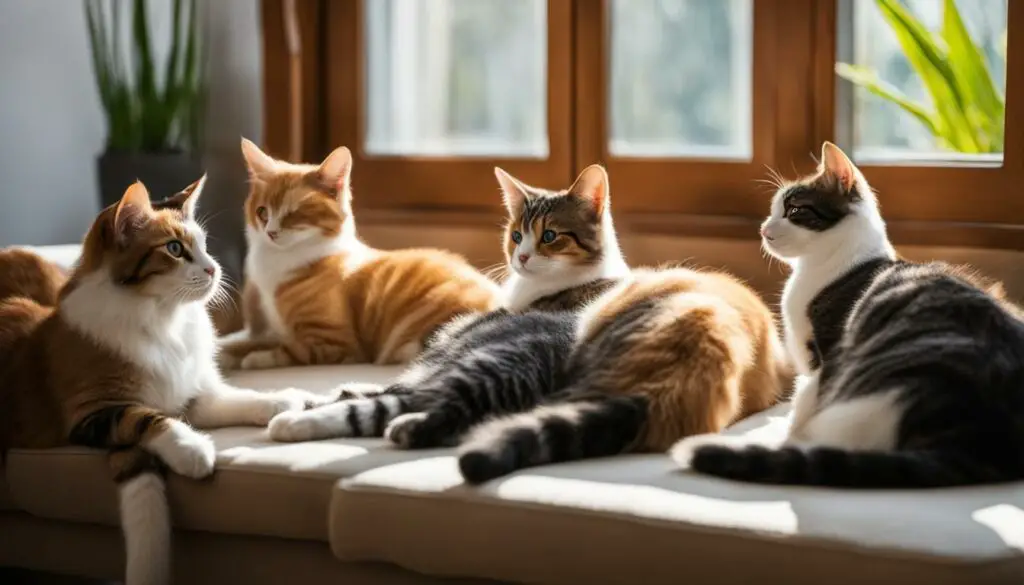
How Cats Show Their Love
Cats have their own unique ways of expressing love and affection towards their humans. Understanding these behaviors can help deepen the bond between you and your feline companion. Here are some common cat affection behaviors that you may observe:
- Rubbing against you: When your cat rubs against your legs or body, it’s a sign of affection. Cats have scent glands in their cheeks and other parts of their bodies, and by rubbing against you, they are marking you as part of their territory.
- Treating you like another cat: Cats may groom you by licking your hair or face, just like they groom their feline companions. This behavior signifies trust and affection.
- Following you into a room: Cats that enjoy your company may follow you around the house, wanting to be near you and be part of your activities.
- Blinking their eyes slowly: A slow blink from your cat is a sign of trust and contentment. It’s their way of saying, “I feel safe and relaxed with you.”
- Kneading their paws: When cats knead their paws against you or a soft surface, it’s a behavior they commonly display when they feel comfortable and happy. It’s reminiscent of their kittenhood, as they used to knead their mother’s belly to encourage milk flow.
- Meowing: Cats vocalize to communicate, and meowing can be a way of seeking attention, expressing affection, or simply saying hello. Each cat has its own unique meow that you’ll learn to interpret over time.
- Showing their bellies: Cats may roll onto their backs and show you their bellies as a gesture of trust and vulnerability. It’s an invitation for gentle belly rubs, but be aware that not all cats enjoy this, as some may be more sensitive in that area.
- Displaying their tails: A cat’s tail can convey their emotional state. A straight upright tail with a slight curve at the tip indicates a friendly and content cat. A puffed-up tail may signal fear or aggression, while a flicking tail could indicate excitement or curiosity.
Understanding these cat affection behaviors can help you strengthen the bond and communication between you and your feline companion. Remember, each cat is unique, so it’s essential to pay attention to your cat’s individual preferences and body language to fully understand and appreciate their love for you.
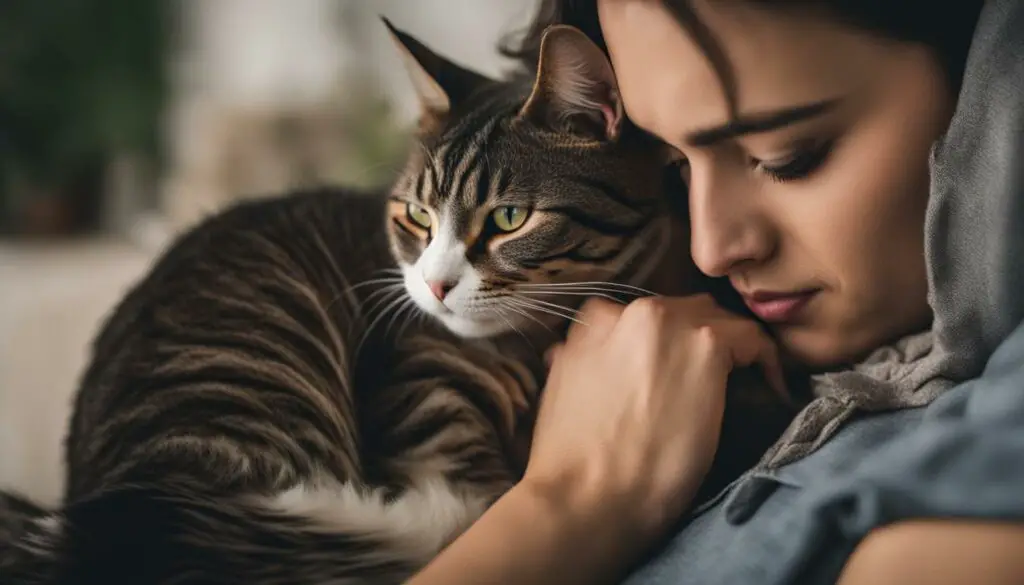
“Cats are connoisseurs of comfort.” – James Herriot
Creating a Comfortable Environment for Love
When it comes to fostering love and affection with your cat, creating a comfortable environment is key. A happy cat is more likely to express their love and build a strong bond with their human companion. To ensure your feline friend feels content and secure, consider the following:
- Provide a cat-friendly environment: Cats thrive in an environment that caters to their natural instincts. Offer vertical spaces like cat trees or shelving for climbing and perching, as well as hiding spots and cozy beds for relaxation. This allows them to engage in their natural behaviors and feel safe and secure.
- Offer environmental enrichment: Keep your cat mentally stimulated by providing toys, scratching posts, and puzzle feeders. This helps prevent boredom and encourages healthy play and exploration, leading to a happier and more affectionate cat.
- Meet their physical needs: Ensure your cat has access to fresh water, a clean litter box, and a nutritious diet. A healthy cat is more likely to feel content and show love towards their owner.
Building Trust and Bonding with Your Cat
Building trust is crucial in any relationship, including the bond between a cat and their human. Here are some tips to strengthen trust and enhance your cat’s love and affection:
- Respect their boundaries: Cats appreciate having their personal space respected. Avoid forcing physical contact or overwhelming them with attention. Instead, allow them to approach you on their terms, gradually building trust and comfort.
- Use positive reinforcement: Reward your cat with treats, praise, and gentle petting when they display behaviors you want to encourage. This reinforces positive associations and deepens the bond between you.
- Establish a routine: Cats thrive on predictability and routine. Stick to a consistent schedule for feeding, playtime, and cuddling. This helps your cat feel secure and loved.
By creating a comfortable environment and building trust with your cat, you can lay the foundation for a strong and loving relationship. Remember, every cat is unique, so pay attention to their individual preferences and needs. With time and patience, your cat will feel loved, and their affection for you will only continue to grow.
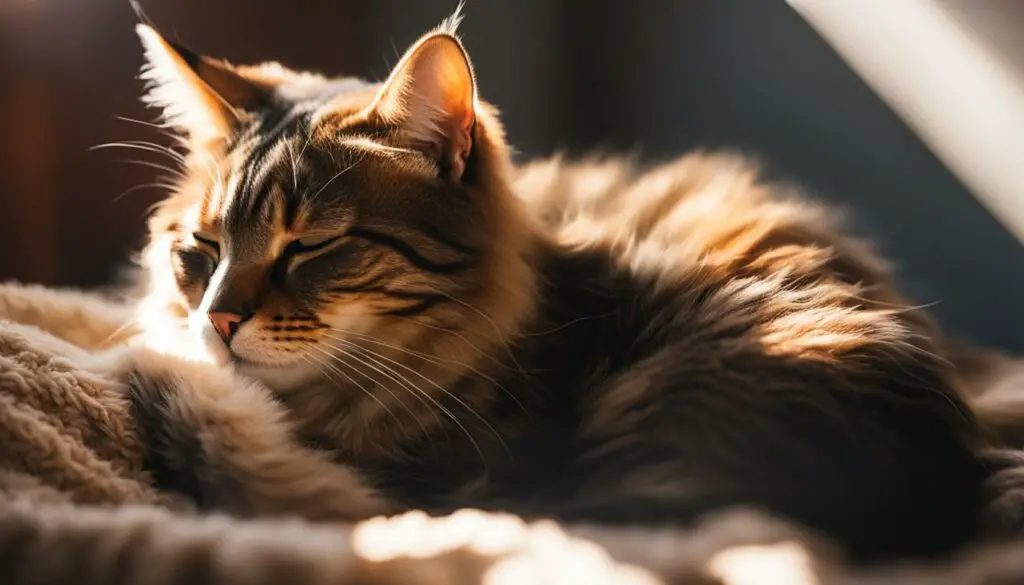
The Universality of Cat Love
When it comes to cat love, there is a universality that transcends breed and personality. While different cat breeds may have specific traits and characteristics, the overall expression of love and affection towards humans remains consistent. Whether you have a playful Abyssinian or a vocal Siamese, the love your cat shows you is a reflection of their innate nature as a loving companion.
Cat behavior, such as slow blinking, headbutting, grooming, kneading, and showing their bellies, is similar across breeds. These behaviors are all ways in which cats express their love and affection towards their humans. Regardless of their breed, cats have their own unique love languages and boundaries, which should be understood and respected to reinforce the bond between cat and human.
Understanding the universality of cat love allows us to appreciate the depth of the feline-human connection. Cats have the ability to form strong bonds with their owners and show unconditional love and loyalty. By acknowledging and reciprocating their love, we can create a harmonious relationship built on trust and affection.
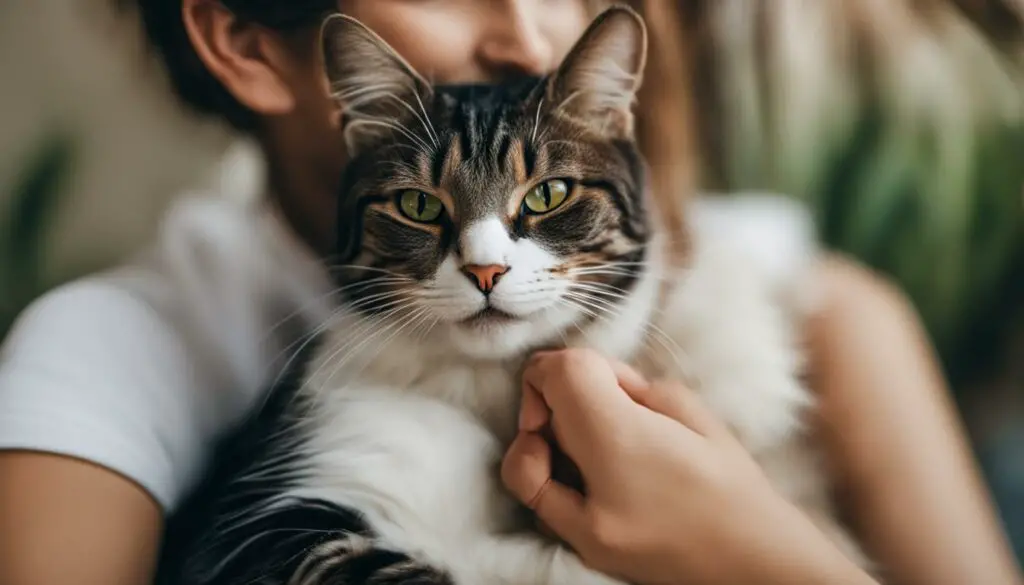
Table: Expressions of Love Across Cat Breeds
| Breed | Characteristic Behaviors |
|---|---|
| Abyssinian | Playful, active, and affectionate. Shows love through interactive play and seeking attention. |
| Siamese | Vocal, social, and demanding. Expresses love through meowing, following their owner, and seeking physical contact. |
| Maine Coon | Gentle, friendly, and loyal. Demonstrates love through gentle headbutts, purring, and being a constant presence. |
| Persian | Calm, gentle, and reserved. Shows love through grooming their owner, cuddling, and being a quiet companion. |
While these examples highlight some breed-specific behaviors, it’s important to remember that the expressions of love and affection vary from cat to cat, regardless of breed. Each cat has its own unique personality and preferences, and understanding and respecting these individual traits are key to nurturing a loving bond.
So whether you have a Maine Coon who loves to follow you around, a Siamese who meows to express their adoration, or a Persian who enjoys gentle grooming sessions, know that the love your cat shows you is a testament to the universal nature of feline companionship.
Cat-Human Interaction: Building Trust and Respecting Boundaries
When it comes to nurturing a loving bond with your cat, understanding their preferences and boundaries is essential. Cats have a unique way of showing affection, and respecting their individual approach can strengthen the connection between you and your feline companion.
Cats, being independent creatures, often prefer to initiate interactions on their own terms. By giving them the space to approach you, you show that you respect their personal boundaries. This dynamic not only fosters a sense of trust but also allows your cat to feel in control and comfortable in your presence.
Building trust with your cat requires patience and understanding. Take the time to observe their body language and cues, such as tail flicks or flattened ears, which may indicate discomfort or a need for space. By being attentive to their signals and responding accordingly, you can create an environment that encourages them to open up and express their love in their own unique way.
Key tips for building trust with your cat:
- Allow your cat to approach you on their terms.
- Respect their personal space and boundaries.
- Observe their body language and respond accordingly.
- Provide a calm and safe environment free from potential stressors.
- Offer positive reinforcement and rewards for desired behaviors.
Remember, every cat is an individual with their own preferences and boundaries. By cultivating an environment that respects their needs, you can forge a deeper connection and foster a loving relationship with your feline friend.
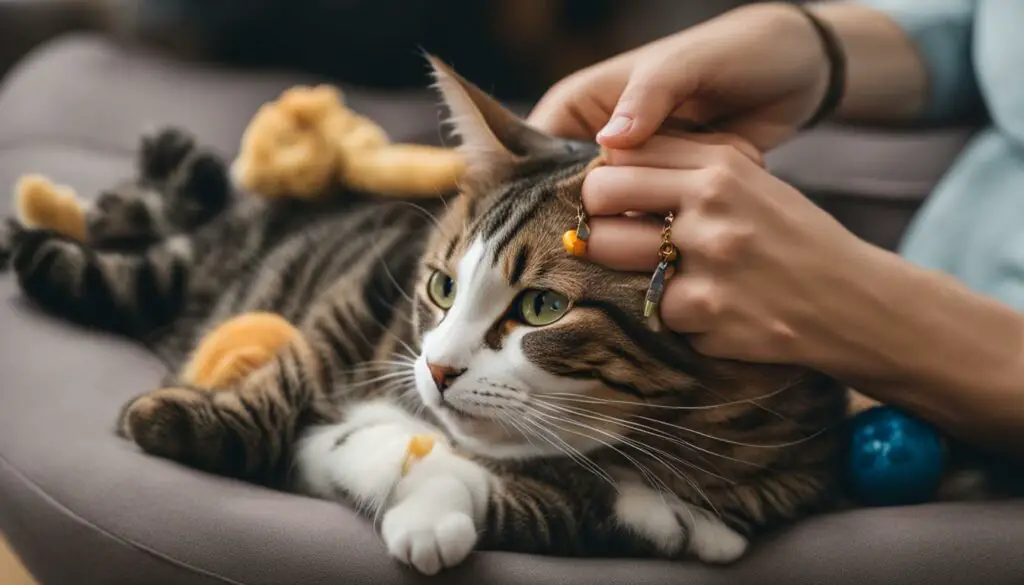
Table: Examples of Cat-Human Interaction
| Interaction Behavior | Description |
|---|---|
| Slow Blinking | A sign of trust and contentment. |
| Headbutting | A way for cats to mark you as part of their territory. |
| Kneading | A sign of comfort and contentment. |
| Purring | Expresses relaxation and happiness. |
| Showcasing Belly | A display of trust and vulnerability. |
By understanding and respecting your cat’s boundaries, you can build a strong foundation of trust and create a loving and harmonious relationship. Allow the love between you and your feline companion to grow naturally, and cherish the unique bond you share.
Finding the Perfect Cat for Your Lifestyle
When it comes to adopting a cat, finding the perfect match for your lifestyle is crucial. Every cat has a unique personality, and selecting one that aligns with your preferences and needs will greatly contribute to building a strong and loving bond. To ensure compatibility, it is essential to evaluate a cat’s personality before adoption. Humane societies and rescue centers often work with cat behaviorists who can assess a cat’s temperament and match them with suitable owners.
During the adoption process, communicate your lifestyle, activity levels, and expectations to the adoption center. This information will help them find a cat that fits well with your routine and living situation. For example, if you prefer a more active cat, they can recommend breeds known for their energy and playfulness. On the other hand, if you desire a calm and relaxed companion, they can guide you towards cats that exhibit those traits.
When adopting a cat, it’s important to consider factors such as your living space, work schedule, and any allergies or sensitivities. Some cats may thrive in smaller apartments, while others may require more room to roam. Cats with specific coat types may be more suitable for individuals with allergies. Taking these factors into account will ensure a harmonious relationship between you and your feline companion.
| Factors to Consider | Compatible Cat Qualities |
|---|---|
| Living space | Consider the cat’s size, energy level, and adaptability to different environments |
| Work schedule | Choose a cat that can adapt to being alone for extended periods or seek a companion for your cat |
| Allergies or sensitivities | Opt for hypoallergenic breeds or cats with shorter fur to minimize potential allergic reactions |
| Activity level | Match your lifestyle to a cat’s energy level, whether you prefer an active playmate or a more relaxed companion |
By carefully considering these aspects and working closely with the adoption center, you can find a cat that not only brings joy to your life but also thrives in your care. Remember, the right cat will not only fit seamlessly into your lifestyle but will also enrich it with love, companionship, and endless moments of happiness.
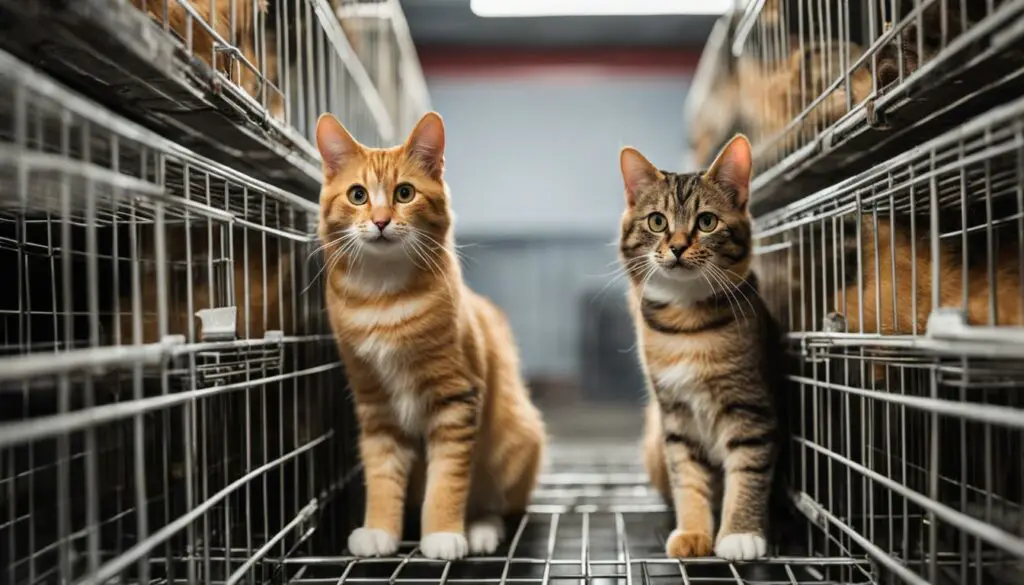
Conclusions
After exploring the fascinating world of cat love, it’s clear that our feline companions have a genuine affection for their humans. By understanding their unique love languages and interpreting their body language, we can strengthen the bond with our cats and build a loving relationship.
Socialization and early interactions play a vital role in a cat’s ability to express love towards humans. Adopting a kitten within the sensitive period of two to nine weeks can contribute to faster bonding and a stronger cat-human relationship. However, cats that have missed this window can still learn to love humans, though it may take more time and patience.
Respecting their boundaries and allowing them to take the lead in interactions can enhance the cat-human bond. Playing hard to get can actually make your cat love you more, as it shows that you understand and respect their need for personal space.
Finally, finding a cat that fits your lifestyle and preferences is crucial for building a strong bond. By choosing a cat with a compatible personality, you lay the foundation for a loving and harmonious relationship. So, remember to cherish the unconditional love and special connection you share with your furry friend. Happy bonding!
FAQ
Do cats really love their humans?
Yes, cats can feel affection for humans and enjoy their presence. They have distinct personalities and show love in various ways.
How do cats show their love?
Cats show love through behaviors like rubbing against you, blinking slowly, kneading their paws, meowing, and displaying their bellies or tails.
What is the importance of socialization in cat love?
Socialization plays a crucial role in a cat’s ability to love humans. It helps them become comfortable coexisting with people and forms a strong bond.
How can I create a comfortable environment for my cat to express love?
Providing a cat-friendly environment with treats, playtime, and environmental enrichment can enhance their ability to express love and strengthen the bond.
Do all cat breeds show love in the same way?
Yes, cat behavior is consistent across breeds. While they may have specific traits, the expressions of love and interaction with humans remain universal.
Should I play hard to get to make my cat love me more?
Yes, allowing your cat to approach you and respecting their boundaries can enhance the cat-human bond and make your cat love you more.
How can I find the perfect cat for my lifestyle?
Working with adoption centers and considering a cat’s personality can help you find a compatible companion that aligns with your lifestyle and preferences.
What are the conclusions of this guide?
This guide emphasizes that cats can and do love their humans. By understanding their love languages, providing a comfortable environment, and respecting their boundaries, you can build a strong and loving relationship with your cat.

